Antarctica Articles 2000


October 2000 - AP
A Maui-sized iceberg has broken free of the Ross Ice Shelf in Antarctica, posing the greatest threat yet of cutting off America's McMurdo research station from annual supply ships.
The new berg, dubbed B-20 by the National Ice Center, was probably knocked loose from the western portion of the Ross Ice Shelf sometime between Sept. 20 and 26.
Measuring 30 by 11.5 miles, B-20 was detected by a Defense Meteorological Satellite on Sept. 27. The cause of the calving is suspected to be the much bigger monster iceberg B-15 which rammed the ice shelf and knocked the smaller berg free, says Ted Scambos of the National Snow and Ice Data Center in Boulder, Colorado.
Computer models predict that B-20 could move west and get caught in the shallows of McMurdo Sound. If it does, the berg itself would not block ships, says Scambos, but the "fast ice" that would fill up the space between the coast and the iceberg would pose a shipping obstacle.
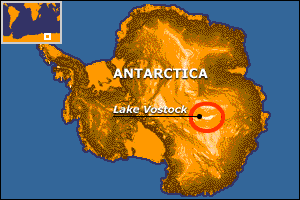
December 11, 1999 - BBC
Analysis of an Antarctic ice core taken from just above the under-ice Lake Vostok suggests that bacteria may live in it.
"The subglacial lakes of East Antarctica may be among the most isolated ecosystems on Earth and could serve as terrestrial analogues to guide the design of samplers and experiments for life probe missions to the ice-covered ocean of Jupiter's moon Europa," says Dr David Karl of the University of Hawaii.
The scientists were examining the ice below Vostok Station, a Russian scientific outpost in the centre of the Antarctic.
Lake Vostok was discovered in 1974 using airborne radio-echo soundings and other techniques. It is one of the world's 10 deepest bodies of water and one of about 70 lakes underneath the glaciers of central Antarctica.
Roughly the size of Lake Ontario, Lake Vostok is the largest and deepest of the lakes, whose fresh water is kept liquid by the pressure of the overlying ice and, perhaps, by geothermal heating.
US, French and Russian scientists have studied fragments taken from an ice core drilled 3,600 meters (11,700 feet) into the ice covering the lake.
Drilling was halted roughly 120 meters (393 feet) above where the ice and liquid water meet, to prevent contamination.
The bacteria, commonly associated with soils, are related to microbes called proteobacteria and actinomycetes. They could have reached Antarctica on bits of soil blown by winds from the Patagonian deserts onto the ice sheet and then buried. If so, the microbes could be more than half a million years old.
"This lake and others like it, may contain previously undescribed relic populations of microorganisms that are adapted for life in these presumably oligotrophic (low-nutrient, low-biomass and low-energy flux) habitats," says Karl.
Scientists at Montana State University have found bacteria within "accreted" ice, which is believed to have refrozen from the lake's waters, suggesting that it can support life. Although the bacteria are similar to other known bacteria scientists wonder whether it may contain larger, more diverse populations.
In addition, the Antarctic ice cores provide a continuous climate record stretching back more than 400,000 years. Obtaining sediment samples from the bottom of Lake Vostok could extend the climate record to cover millions of years.
"From a biologist's perspective, this is the Holy Grail of lake biology," Dr John Priscu of Montana State University said before leaving for another field season on the frozen continent. "Our findings indicate that the microbial world has few limits on our planet."
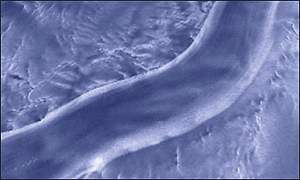
East Antarctic ice streams pour ice into the oceans
The first high-resolution radar map of Antarctica has revealed the frozen continent in such detail that even research huts sat on icebergs can be spotted.
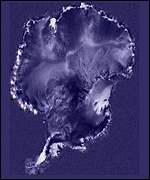
This map is truly a new window on the Antarctic continent, providing new beginnings in our Earth science studies there," said Dr Ghassem Asrar, Associate Administrator for Earth Science at Nasa Headquarters.
Radasat, a Nasa-launched Canadian satellite, spent 18 days in spring 1997 bouncing radar signals from the Earth's surface and analysing the echoes.
Antarctica looks almost featureless with the images from low-resolution satellites that previously mapped the frozen landscape. With the new Radarsat map, however, the continent comes to life.
One can see blocks of broken sea ice that line the coast; sedimentary rock protruding from the rocky walls of Antarctica's Dry Valleys; vast, perplexing ice flows that snake into the sea and volcanoes that poke their heads through the ice sheet.
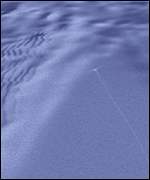
Even the tracks of snow tractors on their way to inland stations are visible, as is the road that runs over the flat ice-cap that overlies Lake Vostok, the largest under-ice sea in the world.
The new map has answered scientists' questions about the icy continent, but it has also left them wondering what to make of strange and fascinating features never seen before.
"We have a new view of the entire southern continent," said Kenneth Jezek, a glaciologist from the Byrd Polar Research Centre at Ohio State University. "It shows us an extraordinary part of our world and how humans may be changing it - on both local and global scales."
Some scientists believe that the most amazing features that can be seen in Radasat's images are twisted patterns of ice flowing from the ice sheet into the ocean.
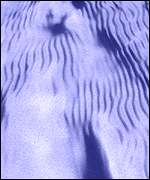
"We were surprised to see a complex network of ice streams reaching deep into the heart of East Antarctica," said Dr Jezek. "There are some extraordinary ice streams that extend almost 500 miles."
Ice streams are vast rivers of ice that flow up to 100 times faster than the ice they channel through, with speeds up to 900 metres (3,000 feet) per year.
It is believed that ice streams form in the most energetic parts of the Antarctic ice sheet, and scientists believe that they are quite susceptible to environmental change. They are important to the long-term stability of the Antarctic ice sheet as they transport most of the snow that falls on the continent's interior back to the ocean.
"We've recently used Radarsat and other satellite data to estimate that one ice stream system sends over 78 cubic kilometres of ice to the sea every year - an amount equivalent to burying Washington DC, in 520 m (1,700 ft) of ice every 12 months," said Dr Jezek.
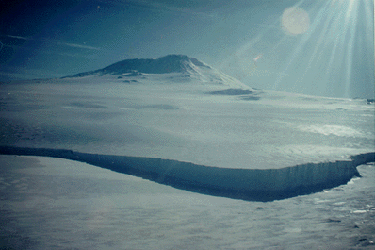
October 6, 1999 - Discovery Online
Lake Vostok is the largest of the lakes that lie beneath the four-kilometre-thick Antarctic ice sheet. After scientists stopped drilling in the ice in 1996 (to avoid contaminating the lake water), scientists were excited to find micro-organisms from 200,000 years ago and there was excited speculation that the lake would hold equally ancient organisms ³seeded² from the ice when the lake formed underneath it. But new data shows Lake Vostok may have existed long before the ice sheet and that the microbes that inhabit its waters may be unchanged since they were first trapped beneath the glaciers, 40 million years ago.
It's making the researchers with the British Antarctica Survey (BAS), sound a lot like explorers venturing into outer space.
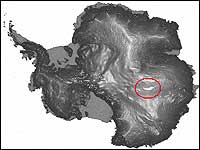
"Is there life down there? It's a fascinating question," says Dr. Cynan Ellis-Evans, a microbiologist with the BAS. ³What kind of microbes could survive in this dark, nutritionally-deprived environment?"
The presence of water underneath the Antarctic ice sheet was first recognized in the 1970s. Using satellite radar and drilling, researchers have shown that Lake Vostok is 500 metres deep and covers an area of 10,000 square kilometres. That makes it one of the largest freshwater bodies in the world - in fact it's comparable in size to Lake Ontario. It is the largest of the 70 or so sub-glacial lakes in Antarctica, and lies under the ice sheet of Eastern Antarctica near the Russian Vostok Station.
But while scientists originally thought that these lakes developed after the ice sheet had reached its present thickness of four kilometres a few million years ago, that figure is being revised markedly. And that makes for a whole new scenario.
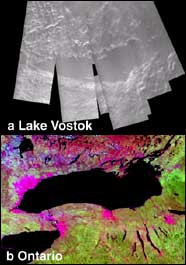
"New modelling data shows the strong possibility that the lake was there 40 million year ago before Antarctica froze over," Ellis-Evans says.
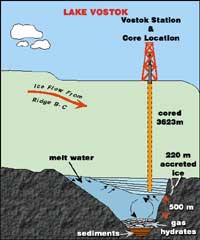
If Lake Vostok was there before the glaciers moved in, says Ellis-Evans, its sediments scoured from the bedrock could provide a record of the glaciation of that continent, a geological record of Antarctica and its climate change. But even more amazingly, there is the possibility that life still exists under the ice life existing in an environment unique among the planetıs ecosystems both unforgiving for its lack of nutrients, and pristine. "Once the lake began to freeze over, there would have been a decline in biodiversity to just microbes," explains Ellis Evans. "[These microbes] would never have been exposed to modern pressures like pollution, antibiotics, climate change, under four kilometres of insulating ice. Usually microbes are forced to change. What happens when an environment is stable for millions of years? There are no references for that!"
At least no references on this planet. One of the moons of Jupiter, Europa, has some interesting similarities.
"On Europa you've got a body of water ice-covered for a very long time," Ellis-Evans points out. "That immediately poses restrictions on the types of life forms and the interaction between ice and water. Thatıs analogous to Vostok."
As a result, NASA has taken a keen interest in Lake Vostok. Their Jet Propulsion Laboratory in Pasadena is planning a Vostok exploration mission within five years, using radar and melting probes, while exploration of Europa is set to start in 2003.
But according to Ellis-Evans, there are more differences than similarities between the two icy environs.
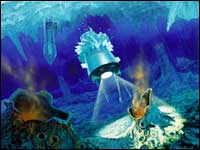
Europa is likely to be salt water, and the ice is unstable, always breaking up. It's more like sea ice, while Vostok has a glacial ice sheet. Europa would have a more dramatic interaction between water and ice, with the bedrock being constantly pulled and pushed by gravity. It's possible it's a volcanic hydrothermal environment. It's not that dramatic in Vostok there's far less energy inputs."
However, Lake Vostok may show Antarctica to be more active than originally thought. While Eastern Antarctica has been regarded as inactive, stable rock for a long period of time, there is now the suggestion that Vostok is sitting in a rift valley: a valley created when tectonic plates split and drift apart (some of worldıs biggest lakes, such as Lake Malawi, sit in rift valleys.)
"Vostok may lie in between two geologically distinct areas of Antarctica,"Ellis-Evans hypothesizes. "If Vostok is sitting in a rift valley, there's a possibility that [Eastern Antarctica] is still active."
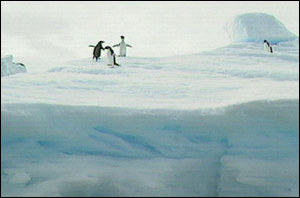
October 7, 1999 - BBC Online
US scientists have suggested that the gradual melting of the huge West Antarctic ice sheet may not be the fault of humankind - at least not yet.
The research concludes that the melting, which began nearly 10,000 years ago, may well continue until the sheet collapses completely. The sheet is about 360,000 square miles in area, roughly the size of Texas and Colorado together.
If it did collapse, global sea levels would rise by up to five or six metres, enough to submerge many coastal regions. But collapse is unlikely, on present trends, for another 7,000 years.
Professor Howard Conway of the University of Washington, one of the scientists involved in the research, said there might be nothing anyone could do to slow or reverse the melting. But he said climate change resulting from human activities could bring about the collapse of the sheet sooner than natural causes would.
Collapse appears to be part of an ongoing natural cycle, probably caused by rising sea levels which were inititated by the melting of the northern hemisphere ice sheets at the end of the last ice age. But the process could easily speed up if we continue to contribute to warming the atmosphere and oceans.
Much of the ice sheet on the Antarctic land mass lies below sea level, which makes it very vulnerable to rising sea levels.
The researchers used evidence gathered from raised beaches - land which rose after the ice pressing it down had melted - and through radar imaging of sub-surface ice structures.
This enabled them to establish that the ice sheet has both thinned and decreased in area since the last glacial maximum, 20,000 years ago.
The ice was once up to 800 metres thick. But melting has relieved its pressure on the land so much that some of the raised beaches are now 30 metres above sea level. The researchers also found that the boundary between floating ice and ice grounded on the sea floor has withdrawn by an average of about 100 metres annually for the last 7,600 years, a total of about 12,800 kilometres (800 miles) since the last ice age. That average is similar to the current rate, and there is no indication that the retreat is slowing.
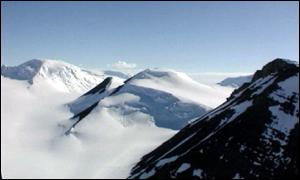
Scientists meeting in Cambridge are discussing whether to drill into a lake beneath the Antarctic ice which may reveal clues to whether life exists on a moon of Jupiter.
Lake Vostok, one of the largest freshwater bodies in the world lies four kilometres below the surface of Antarctica. It is believed by scientists to contain a host of undiscovered lifeforms.
It is also thought that the 10,000 square-kilometre lake may have similarities with the sub-glacial oceans that are believed to exist on the Jovian moon, Europa.
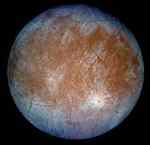
If lifeforms can survive in the extreme conditions of Lake Vostok, scientists believe they may also be able to survive on Europa.
But drilling through the ice into the lake was stopped because of fears that the work would cause contamination.
Now, 70 scientists from 14 countries, are meeting to set the scientific priorities for the next steps in its exploration.
Dr Cynan Ellis-Evans, of the British Antarctic Survey, said: "It has an air of mystery about it which ranks with a lot of the space science.
"We know quite a lot in terms of the ice and the bedrock around the place, but the lake itself is still an enormous mystery to us, especially what sort of lifeforms might be in there.
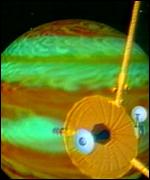
"This is a very old lake and the lifeforms that are going to be in there could be very interesting to us."
When Nasa'a Galileo space probe passed Europa, it discovered the moon had similarities to Antarctica.
The moon is covered with an ice sheet which hides a vast ocean.
"Europa is, from our current calculations, the largest ocean in the solar system."
Lake Vostok could provide a unique technology test-bed and provide an opportunity for Nasa to apply its technical expertise to investigate a novel environment here on Earth.
The lake is situated beneath the ice sheet of Eastern Antarctica in the vicinity of the Russian Vostok Station.
Estimates of the age of Lake Vostok range from hundreds of thousands to millions of years.
ALPHABETICAL INDEX OF ALL FILES